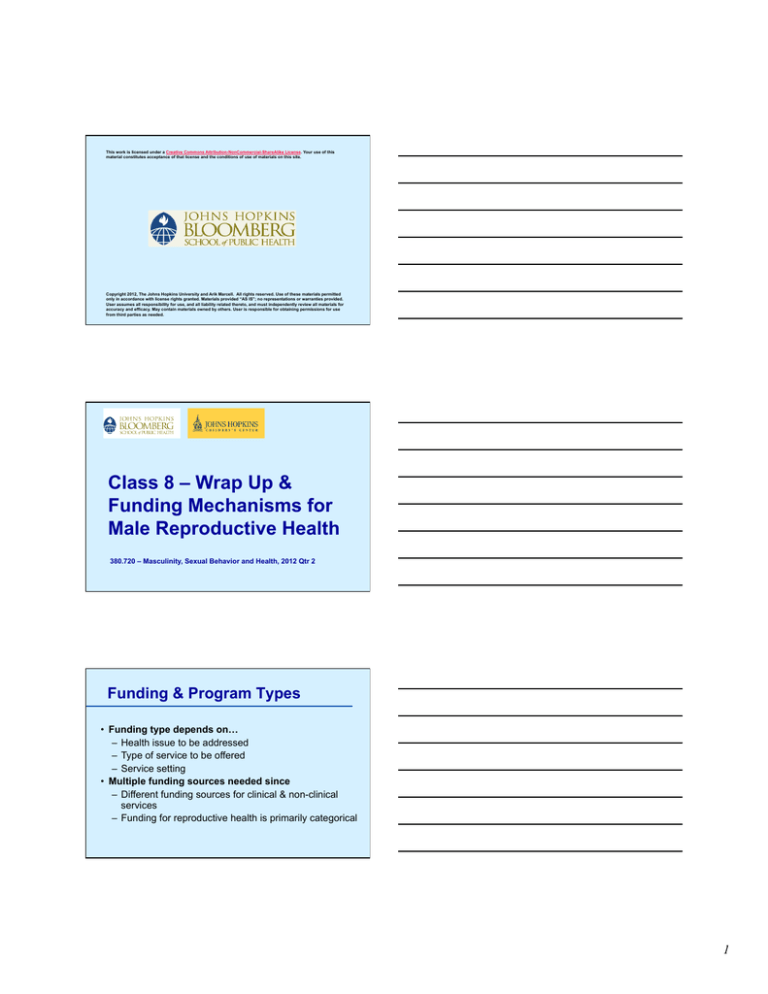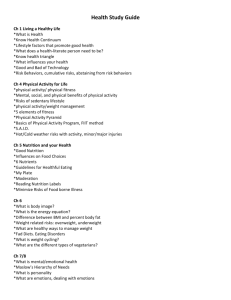
This work is licensed under a Creative Commons Attribution-NonCommercial-ShareAlike License. Your use of this
material constitutes acceptance of that license and the conditions of use of materials on this site.
Copyright 2012, The Johns Hopkins University and Arik Marcell. All rights reserved. Use of these materials permitted
only in accordance with license rights granted. Materials provided “AS IS”; no representations or warranties provided.
User assumes all responsibility for use, and all liability related thereto, and must independently review all materials for
accuracy and efficacy. May contain materials owned by others. User is responsible for obtaining permissions for use
from third parties as needed.
Class 8 – Wrap Up &
Funding Mechanisms for
Male Reproductive Health
380.720 – Masculinity, Sexual Behavior and Health, 2012 Qtr 2
Funding & Program Types
• Funding type depends on…
– Health issue to be addressed
– Type of service to be offered
– Service setting
• Multiple funding sources needed since
– Different funding sources for clinical & non-clinical
services
– Funding for reproductive health is primarily categorical
1
Funding Sources
• Currently no single federal program has a
mandate or mission to serve male adolescents
Service
Type
Clinical
Public Private Insurance
Funding Grants Programs
++
++
++
Education
++
++
-
Counseling
++
++
-
Funding Options
Federal Grants
• Title V -Social Security Act (Maternal & Child Health Block Grant)
• Title X -Public Health Services Act (Federal family planning
program)
• Title XX -Social Security Act (Social Services Block Grant)
• STD/HIV prevention programs-Centers for Disease Control (CDC)
• Community health centers
• Ryan White program (Titles I, II, IV)
• Temporary Assistance for Needy Families (TANF)
• Healthy Marriage Initiative
• CDC STD, HIV, Reproductive Health & School Health programs
Funding Options
Insurance programs
– Medicaid
– SCHIP & other insurance programs
State & Region funding
– Male involvement programs - CA
Other funding
– Local public funds
– Private foundation funds – e.g., Ford Foundation,
California Wellness Foundation
2
Funding: Medicaid
• Federally-funded health insurance program
• Eligibility varies from state to state
– Males <19 years may qualify if child in welfare family, have disability
– Eligibility expansion to parents in families (RI, CA, WI, DOC)
– Services available to low-income childless men (TN, HI, MN, OR, WA)
• Other
– Managed care programs assign patients to “primary care provider”
– Federal “freedom of choice” provision allows individual to seek family
planning services outside managed care network
– EPSDT requirements (Early & periodic screening, diagnosis, &
treatment)
Funding: SCHIP
• Health insurance program established in 1997- Title XXI of the Social
Security Act
• Administered as an expansion of Medicaid coverage for children OR
under a new separately administered plan (or a combined approach)
• Eligibility varies from state to state
• Most teens <19 years with net incomes <200% Federal poverty
Available services
– Broad medical services, including STI/HIV testing & treatment
– Counseling & case management
Other
– Managed care arrangement may limit range of providers
Funding: Title X
• Program dedicated to family planning & administered by the
Office of Family Planning in DHHS
Funding
– Can be used for clinical, educational & counseling services for
males
– Limited funding available – organization needs to be approved
to provide services
Recipients
– Family planning clinics
– Male involvement initiatives
3
Funding: Office of Adolescent Health
• Coordinates adolescent health programs & initiatives across DHHS
related to adolescent health promotion & disease prevention
Funding
• New discretionary grant program to support evidence-based teen
pregnancy prevention approaches.
Recipients
• Pregnancy Assistance Fund – 17 states ($25 million)
– Support for pregnant & parenting student services at institutions of higher education;
– Support for pregnant & parenting teens at high schools & community service centers;
– Improving services for pregnant women who are victims of domestic violence, sexual
violence, sexual assault, & stalking;
– Increasing public awareness & education
• Teen Pregnancy Prevention
- Replication of Evidence-Based Program Models ($75 million)
- Research & Demonstration Programs ($25 million)
Funding: CDC
• Grant programs created to help control & prevent communicable
diseases (HIV & other STIs)
Funding
– Prevention programs for high-risk individuals
– HIV in communities of color
– HIV prevention services in African American faith-based
organizations
– Comprehensive STI prevention systems
Contact
www.cdcnpin.org/db/public/fundmain.htm
Funding: Title V
• MCH block grants to state health departments to improve
maternal & child health
• This is a theoretical funding source but it is subject to
authorization by each state health department
Funding
– Can be used for clinical & educational services
Recipients
– State & local health departments
– Non-profit health clinics
4
Funding: Community Health Centers
• Administered through Health Resources & Services & under
Section 330 of the Public Health Services Act
Funding
– Broad range of primary care services to people living in
underserved areas
Recipients
– Ideal partners for community-based organizations to provide
preventive services to young men
Funding: Ryan White
• Categorical funding to areas with disproportionately high rates
of HIV prevalence
• As part of Title IV, one component funds community-based
projects for children, youth, women, & their families who are
living with or at risk of HIV infection (Pediatric/Family AIDS
Demonstration Program)
Services
– Can provide medical &/or psychosocial services for youth at
high risk for HIV infection
Funding
– Limited (disadvantage)
Funding: Title XX
• Social Services Block Grant distributed by DHHS’s Administration
for Children & Families to state social service agencies
Purpose
– To encourage individual self-sufficiency & reduce individuals’
dependence on government
Funding
– Potentially available for reproductive health activities
– Relevant for male reproductive health as part of a broader social
services program
5
Funding: TANF
• State block grant program replacing Aid to Families with Dependent
Children (AFDC)
Purpose
– Provides cash assistance to needy families, job training & related
services with potential to fund reproductive health services for men
Funding
– Legislation provides $100 million annual bonus to be shared with 5
states with greatest reductions in non-marital birth rates: CA, MI,
AL, MA & DOC
– Youth development focus; Programs with male involvement
components; Programs focusing on young women; Abstinence
education programs
Services
– Family planning is the only medical service that is funded
Healthy Marriage Initiative
• Deficit Reduction Act (2005) provides $150 million each year for
healthy marriage promotion & fatherhood
• Goals include
– Increase percent children raised by 2 parents in healthy marriage
– Increase percent married couples in healthy marriage
– Increase percent premarital couples equipped with skills &
knowledge necessary to form & sustain healthy marriage
– Increase percent youth & young adults with skills & knowledge to
make informed decisions about healthy relationships
– Increase public awareness about value of healthy marriages &
skills & knowledge to help them form & sustain healthy marriages
– Encourage & support research on healthy marriages & healthy
marriage education
– Increase percent of women, men & children in homes free of
domestic violence
Funding: Other Programs
Administration for Children & Families (DHHS)
• Independent Living Program
• Community Services Block Grant
• Runaway and Homeless Youth Programs
• Healthy Marriage Initiative
Health Resources & Services Administration
• Healthy Start
• Healthy Schools, Healthy Communities
Office of Juvenile Justice & Delinquency Prevention
• Youth Violence Initiatives
Department of Labor
• WIA (Workforce Investment Agency)
• Job Corps
6
Advocacy & Support
Men's Health Network
Washington, DC
menshealthnetwork.org
202-543-MHN-1 (6461)
contact: info@menshealthnetwork.org
Top 10 Things to Talk About with Your
Partner & Consider Before Having Sex
First & foremost. . .
1. Develop relationships & not sex. Be honest, communicate &
above all respect each other.
2. The best way to prevent pregnancy & avoid STI/HIVs is to not
have sex.
If you plan on having sex. . .
3. Both get tested before doing the deed.
4. Know that the standard STI lab tests cover only 4 of the possible
33 STIs that one can contract in the world.
5. Don’t drink and bonk.
6. Keep in mind: once your sperm leave the gates, you may not
have final say in what may happen. Talk about pregnancy
decision-making & prevention up front with your partner.
Top 10 Things to Talk About with Your
Partner & Consider Before Having Sex
If you plan on having sex continued. . .
7. Condoms come in many shapes & sizes. . .Don’t like one? Find
another that works & don't forget to use a condom every time you
have sex.
8. Practice makes perfect condom use. Remember: squeeze at the tip,
roll to the base, hold while pulling out. Reduced sensation with a
condom? Try a drop or 2 of lube inside.
9. Find out if your partner is on birth control & doesn't hurt to learn
about hormonal and barrier contraception options as well as how
they are used.
10. Don't forget about Plan B contraception in case a condom breaks or
slips off. It is available over the counter for adult females & good for
use up to 5 days.
11. Sex should be pleasurable. If you're having any issues, find
someone to talk to about it.
7
Top 10 Things to Talk About with Your
Partner & Consider Before Having Sex
Oh yea -• Don't forget to brush your teeth and floss every day.
• Use deodorant & shower daily.
• Eat your breakfast every day (energy is power).
• Call your mom at least once a week to say hi.
8




